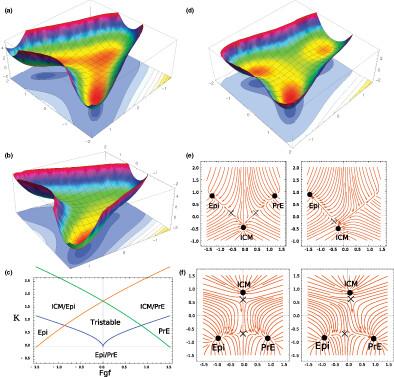A geometrical perspective on development
IF 1.7
4区 生物学
Q4 CELL BIOLOGY
引用次数: 3
Abstract
Cell fate decisions emerge as a consequence of a complex set of gene regulatory networks. Models of these networks are known to have more parameters than data can determine. Recent work, inspired by Waddington's metaphor of a landscape, has instead tried to understand the geometry of gene regulatory networks. Here, we describe recent results on the appropriate mathematical framework for constructing these landscapes. This allows the construction of minimally parameterized models consistent with cell behavior. We review existing examples where geometrical models have been used to fit experimental data on cell fate and describe how spatial interactions between cells can be understood geometrically.

发展的几何视角
细胞命运的决定是一套复杂的基因调控网络的结果。众所周知,这些网络的模型具有比数据所能确定的更多的参数。受沃丁顿景观比喻的启发,最近的研究转而试图理解基因调控网络的几何结构。在这里,我们描述了关于构建这些景观的适当数学框架的最新结果。这允许构建与细胞行为一致的最小参数化模型。我们回顾了现有的例子,其中几何模型已用于拟合细胞命运的实验数据,并描述了如何从几何角度理解细胞之间的空间相互作用。
本文章由计算机程序翻译,如有差异,请以英文原文为准。
求助全文
约1分钟内获得全文
求助全文
来源期刊

Development Growth & Differentiation
生物-发育生物学
CiteScore
4.60
自引率
4.00%
发文量
62
审稿时长
6 months
期刊介绍:
Development Growth & Differentiation (DGD) publishes three types of articles: original, resource, and review papers.
Original papers are on any subjects having a context in development, growth, and differentiation processes in animals, plants, and microorganisms, dealing with molecular, genetic, cellular and organismal phenomena including metamorphosis and regeneration, while using experimental, theoretical, and bioinformatic approaches. Papers on other related fields are also welcome, such as stem cell biology, genomics, neuroscience, Evodevo, Ecodevo, and medical science as well as related methodology (new or revised techniques) and bioresources.
Resource papers describe a dataset, such as whole genome sequences and expressed sequence tags (ESTs), with some biological insights, which should be valuable for studying the subjects as mentioned above.
Submission of review papers is also encouraged, especially those providing a new scope based on the authors’ own study, or a summarization of their study series.
 求助内容:
求助内容: 应助结果提醒方式:
应助结果提醒方式:


